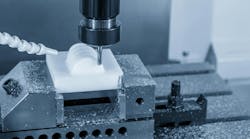CNC machining of plastics typically involves cutting or carving into dense materials, resulting in a lower overall mass. Many manufacturers engaged in such processes must work within modest budgets. That’s particularly true for startups or businesses creating prototypes to prove innovative concepts.
There are many cost-efficient materials to consider for polymer machining. Becoming familiar with these is an excellent way to make the best decisions for upcoming projects.
1. Polycarbonate. Product designers frequently select polycarbonate, which CNC machinists appreciate due to its excellent durability. This material also offers impact resistance and heat tolerance — characteristics supporting numerous real-world uses. This toughness supports polycarbonate’s cost-effectiveness because users of the finished parts can feel confident it will perform well over a long service life.
Besides being one of the most common polymer materials for machining, polycarbonate is easily recycled. That aspect could be important if sustainability is one of your manufacturing plant’s top values.
2. Polypropylene. In addition to its cost-effectiveness, this polymer offers high chemical resistance. Since it also can tolerate repeat sterilizations, polypropylene is often selected by medical device designers specifying a CNC machining process.
Selecting a medical-grade polypropylene also makes the material a shatter-resistant and non-permeable option. Choosing plastics over metal saves money, even when producing a relatively small number of parts. However, a potential downside is that polypropylene has a higher likelihood of melting than other polymers. The manufacturing and usage requirements will determine the material selection to avoid that outcome.
3. ABS for polymer machining. Acrylonitrile butadiene styrene (ABS) is a common, affordable thermoplastic polymer, with costs typically h than polypropylene but less than polycarbonate. This material suits a broad range of manufacturing needs and offers impact resistance.
Since polymers add strength without weight they are often specified for parts designed for the aerospace and aeronautics sectors. If a professional machining company will collaborate with you on a development or prototyping project, be straightforward about your budget and other requirements so those experts can provide the most relevant advice, about ABS or other potential materials.
4. Unreinforced or glass-filled nylon. You can buy nylon for polymer machining as an unreinforced or glass-filled version, the latter being a choice for projects requiring materials with additional rigidity. Carbide-tipped CNC tools — rather than high-speed steel ones — are necessary for working with this option.
Many electronics manufacturers will select CNC machining to enhance internal processes and improve order output volumes. Nylon is a popular material for making hardware to mount printed circuit boards, although its versatility applies to numerous other industries and applications.
5. High-density polyethylene. The selection of this polymer for CNC machining should follow consideration of its polycrystalline structure, which will result in a waxy surface finish. High-density polyethylene (HDPE) offers an excellent strength-to-density ratio, and it resists corrosion. It’s also easily recyclable.
HDPE material is more challenging for machinists to work with than some others described here. However, operators will get good results with single- or double-flute bits and high machine speeds.
6. Polyethylene terephthalate. Polyethylene terephthalate (PET) is an excellent choice for projects by manufacturers that prioritize cost-effectiveness and are seeking a lightweight polymer machining option. Using lighter material options has notable advantages, especially when CNC machining is combined with 3D printing. This option is an emerging, and increasingly popular production route for manufacturing operations that must save time and money.
In one example, the manufacturer used both 3D printing and CNC machining to create stator bores for electric vehicle motors. They started with 3D-printed geometric forms to reduce the parts’ mass. Additionally, choosing a polymer composite for the component’s shaft caused a 40 to 50% weight reduction compared to parts with metal cores.
In another approach, manufacturers have explored recycled PET and standard polymer blends to create high-tensile strength composites.
7. Polyvinyl chloride. Polyvinyl chloride (PVC) is one of the most widely used plastics, particularly for weather-resistant parts or those for which long-term service is a requirement. PVC is available in rigid and flexible varieties, and some machinists use additives to make it easier to handle.
The manufacturer should select water-soluble coolants to prevent CNC machines from overheating as they work with this PVC. Sharp cutting tools will give the best results, and high cutting forces or excessive clamping are typically unnecessary when machining polyvinyl chloride.
Take a balanced approach
A final consideration in selecting polymer materials is that cost efficiency is only one aspect of successful CNC machining. Saving money is an understandable aim, but you must also ensure the chosen material will withstand the machined product’s intended application. The associated issues could overshadow the anticipated cost-saving benefits if that does not happen.
Study similar projects and commercial products to learn about the most popular polymers for specific applications. When designing a program to meet a client’s specifications, always discuss relevant details, such as how cost-related trade-offs could cause untended performance shortcomings.
Additionally, when choosing third-party providers to assist with upcoming projects, rely on their expertise and listen to their advice about staying within budget while addressing other needs. You can obtain quotes to see if purchasing materials in bulk may make costs more reasonable and allow you to use more of your budget for an option costing slightly more than you’d planned to pay.
Emily Newton is the Editor-in-Chief of Revolutionized, an online magazine exploring the latest industrial innovations.






